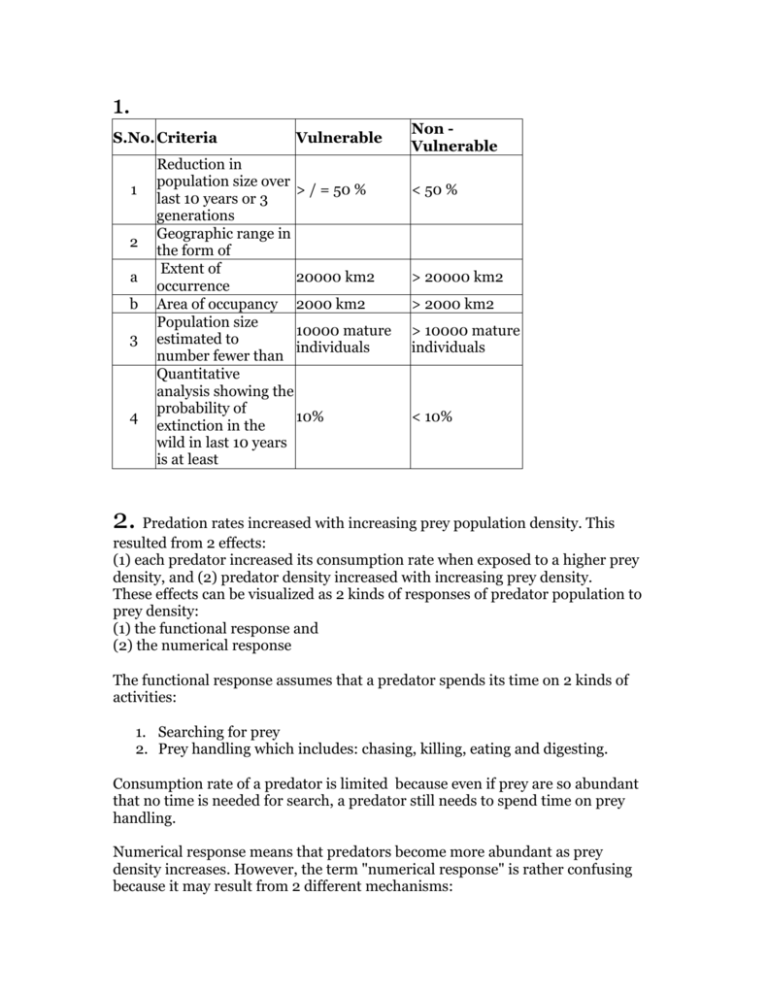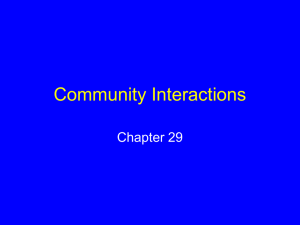1 - BrainMass
advertisement

1. S.No. Criteria 1 2 a b 3 4 Vulnerable Reduction in population size over > / = 50 % last 10 years or 3 generations Geographic range in the form of Extent of 20000 km2 occurrence Area of occupancy 2000 km2 Population size 10000 mature estimated to individuals number fewer than Quantitative analysis showing the probability of 10% extinction in the wild in last 10 years is at least Non Vulnerable < 50 % > 20000 km2 > 2000 km2 > 10000 mature individuals < 10% 2. Predation rates increased with increasing prey population density. This resulted from 2 effects: (1) each predator increased its consumption rate when exposed to a higher prey density, and (2) predator density increased with increasing prey density. These effects can be visualized as 2 kinds of responses of predator population to prey density: (1) the functional response and (2) the numerical response The functional response assumes that a predator spends its time on 2 kinds of activities: 1. Searching for prey 2. Prey handling which includes: chasing, killing, eating and digesting. Consumption rate of a predator is limited because even if prey are so abundant that no time is needed for search, a predator still needs to spend time on prey handling. Numerical response means that predators become more abundant as prey density increases. However, the term "numerical response" is rather confusing because it may result from 2 different mechanisms: 1. Increased rate of predator reproduction when prey are abundant (numerical response per se) 2. Attraction of predators to prey aggregations ("aggregational response") Reproduction rate of predators naturally depends on their predation rate. The more prey consumed, the more energy the predator can allocate for reproduction. Mortality rate also reduces with increased prey consumption 3. In Batesiian mimics the mimic resembles the successful species but does not share the attribute that discourages predation. Mimic in this case is defenseless. e.g., Monarch butterfly (contains toxins in body) is mimicked by Viceroy butterfly (contains no toxins) In Müllerian mimics the mimic resembles the successful species and shares the anti-predation attribute. Mimic share the same defense mechanism as those of model. e.g., Monarch butterfly (contains toxins in body) is mimicked by Queen butterfly (contains toxins) 4. Micro & Macroparasite Character Body Size Intrinsic rate of population growth Interactions with host individuals in natural population Effect of the interaction on host Stability of the interaction Ability to regulate lower tropic level Micro parasite Very smaller than host Much faster than host Macro parasite Smaller than host Faster than host One host usually supports several population of different species Mildly to fairly deleterious Intermediate One host supports few to may individuals of species Moderate Low Intermediate High 5. Mutualism is relationship between two organisms that benefit both. In facultative mutualism partners can survive in the absence of mutualism and can lead independent life. Plant – Myccorrhiza is an example of facultative mutualism. However, in Obligatory mutualism partners cannot survive independently. For survival both partner has to enter into mutualism. Lichen for example is obligate mutualism between specific fungi & specific algae. In the absence of such association both fungi and algae will not survive. 6. In ecology, a niche is a term describing the relational position of a species or population in an ecosystem. More formally, the niche includes how a population responds to the abundance of its resources and enemies (e. g., by growing when resources are abundant, and predators, parasites and pathogens are scarce) and how it affects those same factors (e. g., by reducing the abundance of resources through consumption and contributing to the population growth of enemies by falling prey to them). The abiotic or physical environment is also part of the niche because it influences how populations affect, and are affected by, resources and enemies. The full range of environmental conditions (biological and physical) under which an organism can exist describes its fundamental niche. As a result of pressure from, and interactions with, other organisms (e.g. superior competitors) species are usually forced to occupy a niche that is narrower than this and to which they are mostly highly adapted. This is termed the realized niche








